Lexus IS250 IS220d GSE20 ALE20 4GR-FSE ENGINE MECHANICAL
ENGINE - ON-VEHICLE INSPECTION
| 1. INSPECT ENGINE COOLANT |
Inspect the engine coolant .
| 2. INSPECT ENGINE OIL |
Inspect the engine oil .
| 3. INSPECT BATTERY |
Inspect the battery .
| 4. INSPECT SPARK PLUG |
Inspect the spark plug .
| 5. INSPECT AIR CLEANER FILTER ELEMENT SUB-ASSEMBLY |
Remove the air cleaner filter element sub-assembly.
Visually check that there is no dirt, blockage, and/or damage to the air cleaner filter element.
- HINT:
| 6. INSPECT VALVE LASH ADJUSTER NOISE |
Rev up the engine several times. Check that the engine does not emit unusual noises.
If unusual noises occur, warm up the engine and idle it for over 30 minutes. Then perform the inspection above again.
If any defects or problems are found during the inspection above, perform a lash adjuster inspection.
| 7. INSPECT IGNITION TIMING |
Warm up the engine and stop the engine.
- NOTICE:
- A warmed up engine should have an engine coolant temperature of over 80°C (176°F), have an engine oil temperature of 60°C (140°F), and the engine rpm should be stabilized.
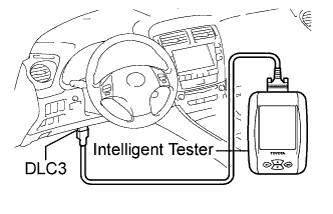
When using the intelligent tester:
Connect the intelligent tester to the DLC3.
Start the engine and idle it.
Push the intelligent tester main switch ON.
Enter the following items: Powertrain / Engine and ECT / Data list / IGN Advance.
- Ignition timing:
- 5 to 15° BTDC at idle
- HINT:
- Refer to the intelligent tester operator's manual for further details.
When not using the intelligent tester:
Remove the V-bank cover sub-assembly.

Connect the tester probe of a timing light to the wire of the ignition connector for No. 1 cylinder.
- NOTICE:
- Use a timing light which can detect the primary current.
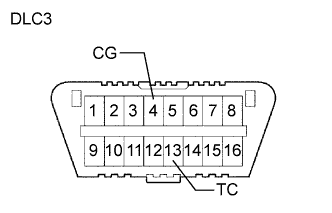
Using SST, connect terminals TC and CG of the DLC3.
- SST
- 09843-18040
- NOTICE:

Using a timing light, check the ignition timing.
- Ignition timing:
- 8 to 12 BTDC at idle
Remove the SST from the DLC3.
Check the ignition timing.
- Ignition timing:
- 5 to 15° BTDC at idle
Check that the ignition timing advances immediately when the engine speed is increased.
Disconnect the timing light from the engine.
Install the V-bank cover sub-assembly.
| 8. INSPECT ENGINE IDLE SPEED |
Warm up and stop the engine.
- NOTICE:
- A warmed up engine should have an engine coolant temperature of over 80°C (176°F) and an engine oil temperature of 60°C (140°F), and the engine rpm should be stabilized.

When using the intelligent tester:
Connect the intelligent tester to the DLC3.
- NOTICE:
- Switch off all accessories and A/C before connecting the intelligent tester.
Race the engine speed at 2,500 rpm for approx. 90 seconds.
Push the intelligent tester main switch ON.
Enter the following items: powertrain / Engine and ECT / Data list / Engine SPD.
- Idle speed:
- 650 to 750 rpm
- NOTICE:
- When checking the idle speed, the transmission should be in the neutral.
- HINT:
- Refer to the intelligent tester operator's manual for further details.
If the idle speed is not as specified, check the air intake system.
Disconnect the intelligent tester from the DLC3.
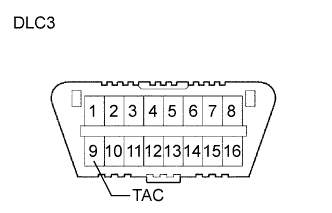
When not using the intelligent tester:
Using SST, connect the tachometer probe to terminal TAC of the DLC3.
- SST
- 09843-18040
- NOTICE:
- Confirm the terminal numbers before connecting them. Connecting the wrong terminals can damage the engine.
Race the engine speed at 2,500 rpm for approx. 90 seconds.
Check the idle speed.
- Idle speed (Transmission neutral position):
- 650 to 750 rpm
If the speed is not as specified, check the air intake system.
Disconnect the tachometer from the DLC3.
| 9. INSPECT COMPRESSION |
Warm up and stop the engine.
- NOTICE:
- A warmed up engine should have an engine coolant temperature of over 80°C (176°F) and an engine oil temperature of 60°C (140°F), and the engine rpm should be stabilized.
Remove the cool air intake duct seal.
Remove engine room side cover LH.
Remove engine room side cover RH.
Remove the V-bank cover.
Remove the air cleaner inlet No. 1.
Remove the air cleaner cap with the air cleaner hose.
Remove the intake air surge tank.
Disconnect the 6 injector connectors.
Remove the 6 ignition coils.
Remove the 6 spark plugs.

Disconnect the 2 injector driver connectors as shown in the illustration.
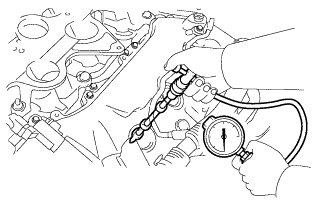
Insert a compression gauge into the spark plug hole.
While cranking the engine, measure the compression pressure.
- HINT:
- Always use a fully charged battery to obtain engine speed of 250 rpm or more.
- NOTICE:
- The measurement must be done as quickly as possible.
- Standard compression pressure:
- 1.4 MPa (14 kgf*cm2, 199 psi) or more
- Minimum pressure:
- 0.98 MPa (10.0 kgf*cm2, 142 psi)
Perform the inspection above for each cylinder.
- Difference between each cylinder:
- 0.1 MPa (1.0 kgf*cm2, 15 psi) or less
If the cylinder compression in one or more cylinders is low, pour a small amount of engine oil into the cylinder through the spark plug hole. Then perform the first 3 steps under "inspect the cylinder compression pressure" for the cylinders with low compression.
- HINT:

Connect the 2 injector driver connectors as shown in the illustration.
Install the 6 spark plugs.
- Torque:
- 25 N*m{ 254 kgf*cm, 18 ft.*lbf}
Install the 6 ignition coils.
- Torque:
- 10 N*m{ 102 kgf*cm, 7 ft.*lbf}
Connect the 6 injector connectors.
Install the intake air surge tank.
Install the air cleaner cap with the air cleaner hose.
Install the air cleaner inlet No. 1.
- Torque:
- 5.0 N*m{ 51 kgf*cm, 44 in.*lbf}
Install the V-bank cover.
Remove the engine room side cover LH.
Remove the engine room side cover RH.
Install the cool air intake duct seal.
| 10. INSPECT CO/HC |
- HINT:
- This check for determining whether or not the idle CO / HC complies with regulations.
Start the engine.
Keep the engine speed at 2,500 rpm for approx. 180 seconds.
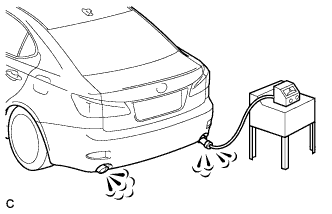
Insert the CO / HC meter testing probe at least 40 cm (1.3 ft) into the tailpipe during idling.
Immediately check CO / HC concentration at idle and / or 2,500 rpm.
- HINT:
Check the A/F sensor and heated oxygen sensor operation.
See the table below for possible causes, then inspect and correct the applicable causes if necessary.
| CO | HC | Symptom | Causes |
| Normal | High | Rough idle | 1 .Faulty ignitions Incorrect timing Fouled, shorted or improperly gapped plugs 2. Leaky intake and exhaust valves 3. Leaky cylinder |
| Low | High | Rough idle (Fluctuating HC reading) | 1. Vacuum leaks PCV hose Intake manifold Throttle body 2. Lean mixture causing misfire |
| High | High | Rough idle (Black smoke from exhaust) | 1. Restricted air filter 2. Faulty fuel SFI system Faulty pressure Defective ECT sensor Faulty ECM Faulty injector Faulty throttle position sensor Faulty MAF sensor |